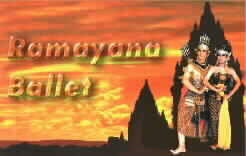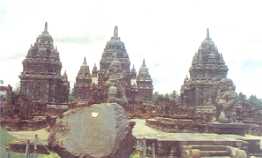|
Temples

THE PRAMBANAN PLAIN
Prambanan temple is located some 17 kilometers
from Yogyakarta. One can not miss the temple because it is only 100
meters off the main road.
This 47 high Hindu Temple was
built by Sanjaya Dynasty in the 9 century. It consists of three
courtyards. The main temple is located in the inner courtyard and
surrounded by several small temples called ‘Perwara’ Temples. Some
of these where contribute by local chieftains as a token of there
acquiescence to the king.
As a Hindu Temple, the main
temple has three shrines, to the Hindu Trinity; Ciwa, Whisnu, and
Brahma. Each of this shrines facing to a smaller shrines for their
vehicles. The cow Nandi is the vehicle of Ciwa, the destroyer god;
the eagle Garuda is the vehicle of Whisnu, the creator god, and the
swan Angsa is the vehicle of Brahma, the guardian god.
 Entering the main temple from the north, one will
find a statue of a very beautiful princess, Roro Jonggrang.
According to the legend, Roro Jonggrang was the daughter of King
Boko who was cursed into a statue. Entering the main temple from the north, one will
find a statue of a very beautiful princess, Roro Jonggrang.
According to the legend, Roro Jonggrang was the daughter of King
Boko who was cursed into a statue.
The legend
says that a young powerful man named Bandung Bondowoso wants to
marry Roro Jonggrang. Since she doesn’t love him, Roro Jonggrang
tries to avoid the marriage by asking Bandung Bondowoso a present.
She will marry him if Bandung Bondowoso is really a powerfulman.
Bandung Bondowoso is required to build a thousand temples in one
night. Having supernatural power, Bandung Bondowoso was almost
successfully finishing the task. But Roro Jonggrang still tries to
prevent the good work. She asks the maidens east of the village of
the temples to burn the hay and pound the rice, so that cause the
situation like dawn and time for sunrise. When the cock began to
crow, all the supernatural being flee because they think the dawn
has come. Being unable to control his anger, Bandung Bondowoso
curses Roro Jonggrang into a statue that now complete the
temple.
Relief depicting the heavenly
creatures were carved around the food of the Civa temple symbolizing
the cosmic system. Entering the temple from the south and walking
around the sub base of the temple with the main shrine on your right
(Pradaksina) one will see the whole relief of the story of Ramayana.
The story ends at the relief carved on the balustrade of Brahma
temple. The story of Kresnayana which tells the childhood of Prabu
Kresna, can be seen on the balustrade of Whisnu temple.

From May to
October, at full moon...
The story of Ramayana is
usually presented in the evening from 07.00 pm to 9.00 pm. As a
traditional dance the dance is performed on an open air stage to the
west of the temple.
 SEWU
TEMPLE SEWU
TEMPLE
Sewu temple is
located just several hundred maters north-east of Prambanan temple.
It is a large and vast Buddhist temple including several other small
temples like Lumbung, Asu, Bubrah, and Lor Kulon temple. About one
kilometers east of sewu temple lies Plaosan Temple.
BANYU
NIBO TEMPLE
Banyu Nibo
temple can be visited easily after visiting King Boko temple. It is
located solitarily amid the farmland about two kilometers southeast
of King Boko’s Palace, flanked by Gunung Kidul hills to the
south.
KALASAN
TEMPLE
This Unique
Buddhist temple is located some 16 km east of Yogyakarta on the
south side of the main road between Yogyakarta and Prambanan. The
temple was built in the honor of the marriage between King Pancapana
of the Sanjaya Dynasty and a Princess of the Cailendra Dynasty, Dyah
Pramudya Wardhani. It is beautifully ornamented with finely carved
reliefs and coated with “Vrajalepa”, a yellowish material made of
the sap of certain three. The Vajralepa functioned as adhesive and
as a protection against moss and mildew, and refined the carving as
well. Sari
Temple, one of the Buddhist
temple is located about 600 meters north east of Kalasan
 SAMBISARI TEMPLE SAMBISARI TEMPLE
The temple, which has been restored recently, is located
some 12 kilometers east of Yogyakarta, on the north of the main road
between Yogyakarta and Solo.
Sambisari temple is very
unique, it lies 6,5 meters bellow the ground level. It was erected
in the 10th century. Because of the eruption of mount Merapi in
1006 the area surrounding the temple covered with volcanic
material.
 
 
| 
